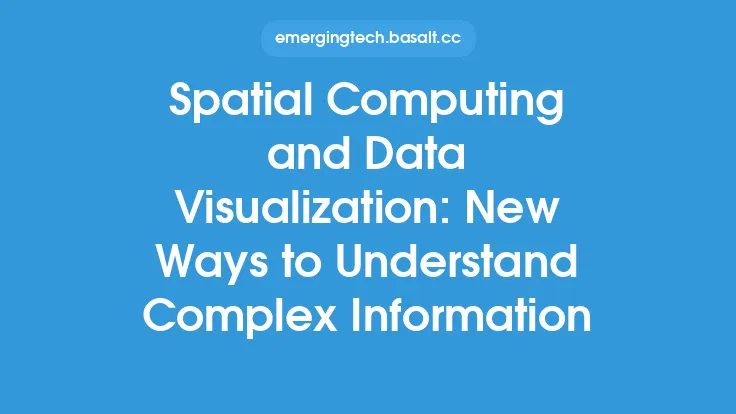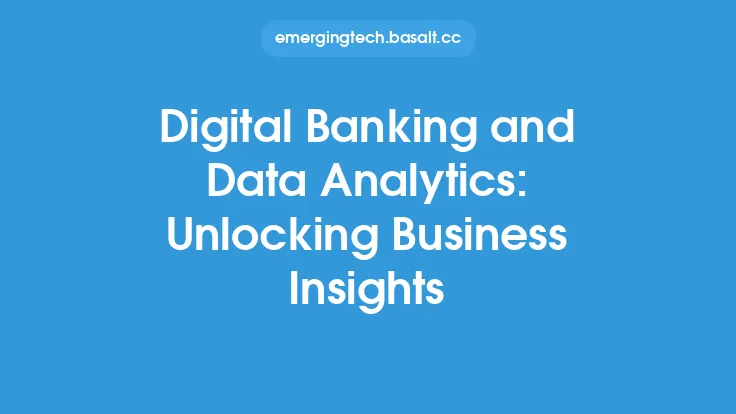The concept of immersive data visualization has revolutionized the way we interact with and understand complex data. By leveraging immersive technologies such as virtual reality (VR) and augmented reality (AR), individuals can now step into a three-dimensional representation of their data, gaining new insights and perspectives that were previously unimaginable. This innovative approach to data analysis has far-reaching implications, enabling users to uncover hidden patterns, trends, and correlations that might have gone undetected through traditional two-dimensional visualization methods.
Introduction to Immersive Data Visualization
Immersive data visualization combines cutting-edge technologies with advanced data analysis techniques to create interactive, immersive environments that facilitate a deeper understanding of complex data sets. By utilizing VR or AR, users can navigate and explore their data in a fully interactive and engaging manner, allowing them to identify relationships and connections that might have been obscured in traditional visualizations. This approach has been successfully applied in various fields, including business, science, engineering, and healthcare, where the ability to analyze and understand large amounts of data is crucial for informed decision-making.
Key Technologies and Tools
Several key technologies and tools are driving the development of immersive data visualization. These include VR and AR platforms, such as Oculus, Vive, and HoloLens, which provide the necessary hardware and software infrastructure for creating immersive environments. Additionally, specialized software tools, such as Unity and Unreal Engine, are used to design and develop interactive data visualizations. Other important technologies include data analytics platforms, such as Tableau and Power BI, which provide the necessary data processing and visualization capabilities. Furthermore, programming languages like Python, R, and JavaScript are used to develop custom data visualization applications and integrate them with immersive technologies.
Applications and Use Cases
Immersive data visualization has a wide range of applications and use cases across various industries. In business, it can be used to analyze customer behavior, optimize supply chains, and identify new market opportunities. In science, it can be used to visualize complex phenomena, such as climate patterns, molecular structures, and astronomical data. In engineering, it can be used to design and optimize complex systems, such as buildings, bridges, and manufacturing processes. In healthcare, it can be used to analyze medical imaging data, track disease outbreaks, and develop personalized treatment plans. These are just a few examples of the many potential applications of immersive data visualization.
Benefits and Advantages
The benefits and advantages of immersive data visualization are numerous. One of the primary advantages is the ability to uncover hidden patterns and relationships in complex data sets. By interacting with data in a fully immersive environment, users can identify connections and correlations that might have gone undetected through traditional visualization methods. Additionally, immersive data visualization can facilitate collaboration and communication among stakeholders, enabling them to share insights and perspectives in a more engaging and interactive manner. Furthermore, immersive data visualization can enhance user engagement and retention, making it easier for individuals to understand and work with complex data.
Challenges and Limitations
Despite the many benefits and advantages of immersive data visualization, there are also several challenges and limitations that need to be addressed. One of the primary challenges is the need for specialized hardware and software infrastructure, which can be expensive and require significant technical expertise. Additionally, immersive data visualization requires large amounts of high-quality data, which can be difficult to obtain and prepare. Furthermore, there are also concerns about user experience and comfort, as immersive environments can be disorienting and cause motion sickness in some individuals. Finally, there are also ethical considerations, such as ensuring that immersive data visualizations are accurate, unbiased, and respectful of user privacy.
Best Practices and Guidelines
To ensure the effective use of immersive data visualization, it is essential to follow best practices and guidelines. These include carefully planning and designing the immersive environment, selecting the most appropriate data visualization tools and techniques, and ensuring that the user experience is engaging, interactive, and comfortable. Additionally, it is essential to validate the accuracy and reliability of the data, as well as to ensure that the immersive visualization is unbiased and respectful of user privacy. Furthermore, it is also important to provide users with clear instructions and guidance on how to navigate and interact with the immersive environment, as well as to ensure that the visualization is accessible and usable by a wide range of users.
Future Directions and Opportunities
The future of immersive data visualization is exciting and full of opportunities. As immersive technologies continue to evolve and improve, we can expect to see even more sophisticated and interactive data visualizations. One of the most promising areas of research is the integration of artificial intelligence (AI) and machine learning (ML) with immersive data visualization, which could enable the development of even more advanced and autonomous data analysis capabilities. Additionally, the increasing availability of high-quality data and the growing demand for data-driven insights will drive the adoption of immersive data visualization across various industries and applications. Finally, the potential for immersive data visualization to enhance user experience, facilitate collaboration, and drive business innovation will continue to drive investment and innovation in this field.





